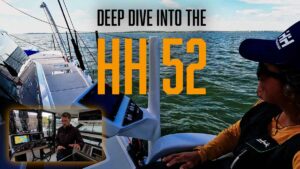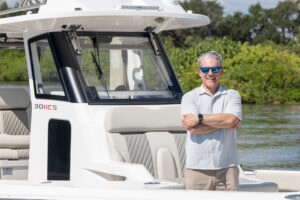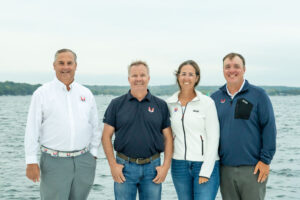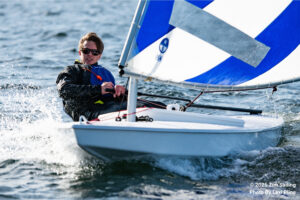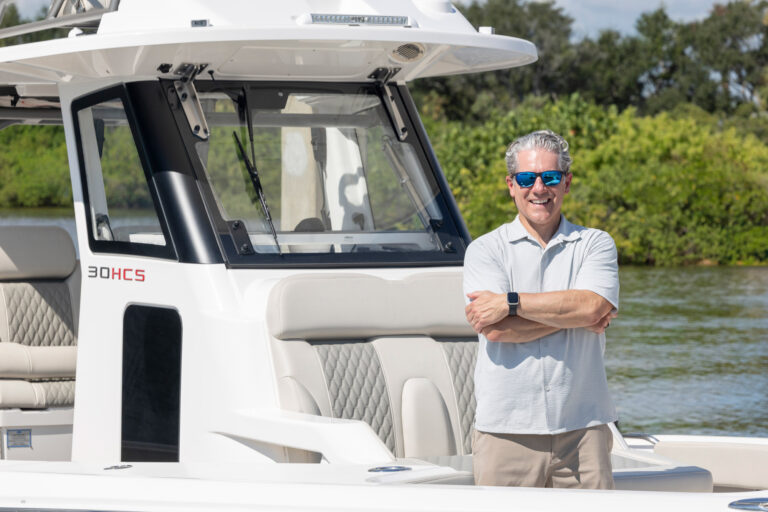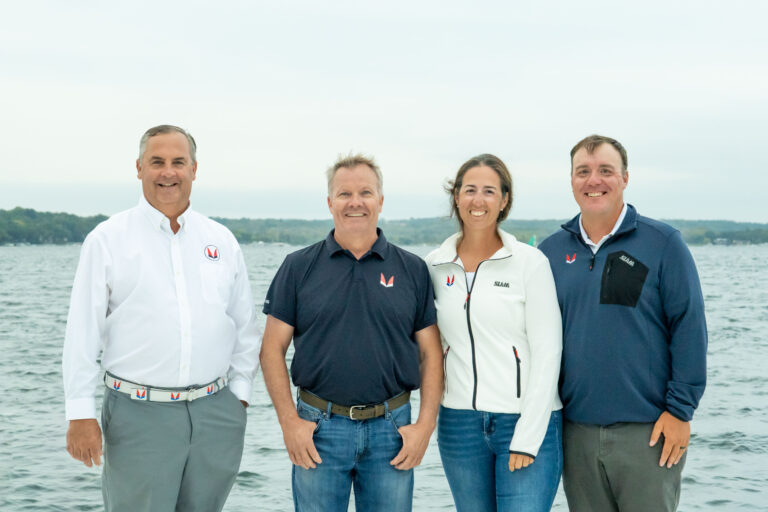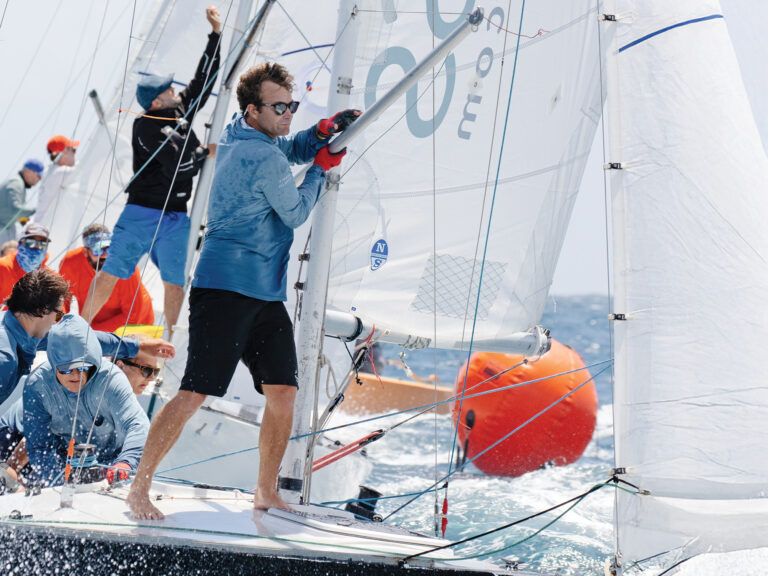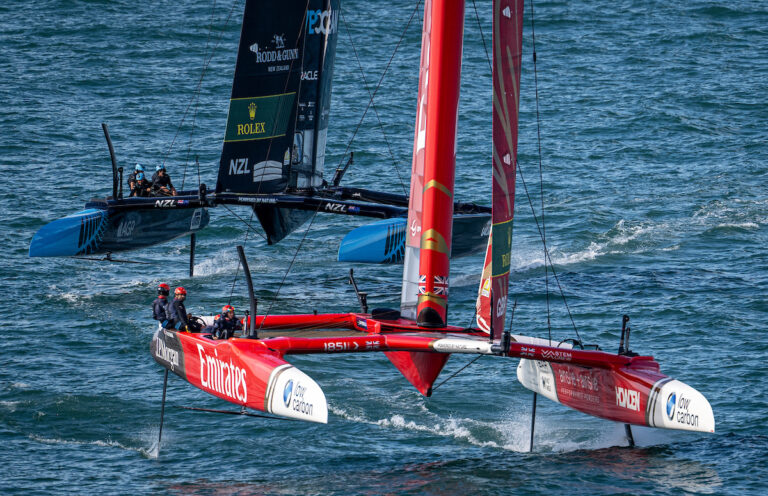
When the judges walked down the dock to take our first look at the Farr 395, the excitement was like a Christmas morning. The Farr Office has a reputation for delivering fast racing boats, and Carroll Marine is no stranger to the winners circle of Sailing Worlds Boat of the Year competition having 7 previous awards, including the Overall winner in 1998 –the Farr 40 One-Design.
Viewed from the dock, the 395 has a purposeful but well-proportioned look. Some purists might not like the plumb bow and short overhang aft but thats the look of the new millennium and it helps to create a faster, higher volume boat for the LOA. The profile angles are in concert with each other and the cabin house is well styled. All of the judges gave the boat good marks for aesthetics.
Our next step was to analyze the ergonomics. Overall, the cockpit was comfortable. The seatback angles were a little vertical for dockside lounging, but were as good or better than most of the boats we tested. The helm seat area will accommodate many different sitting styles. The large wheel diameter makes steering the boat nice. You can sit on the weather rail and watch the waves and jib telltales, or you can steer to leeward in light airs. The foot braces for the helmsman are well located and its easy to lock yourself into position. One interesting innovation in the cockpit is a removable cockpit locker/seat that comprises the after portion of the seats. When removed, the locker is replaced by a stainless-steel footrest for the mainsail trimmer. This allows flexibility in the cockpit layout although when sailing and sitting up on the side deck, I actually found it more comfortable to leave the seat in. By keeping my feet firmly on the seat, my thigh wasnt resting on the mainsheet. The side decks are wide its easy to move around this boat.
One small quibble that fellow judge Lynn Bowser and I noticed was that, while standing at the wheel you had to duck your head under the backstay if the cylinder was fully extended. Theres a solution for this though, the backstay has a quick release from the cylinder so that while going downwind in light air you can disconnect it and run it forward.
One reason it was so easy to feel comfortable on this boat was the hardware selection and layout. The decisions were obviously made by someone that goes racing. Just looking at the organization of the control lines and winches brought a smile to my face. They didnt try to be fancy or innovative, instead they used systems that have been tried, tested and found true. I really liked their use of the mainsheet system that has been labeled the “German Admirals Cup” style. This system carries the sheet forward along each side of the boom to the gooseneck and then down to the deck near the chainplates. From here it runs back to a winch by the traveler. When you have a sail large enough to require winches this works great. The obvious advantage is that you have the control of the mainsheet and traveler at one location. Also, during windy jibes, a crewmember at the mast can help the mainsail trimmer by overhauling the mainsheet. The sheet is led above the deck and while not as “trick” as running the sheet under deck, it has less friction. Another little touch I liked was leading the main outhaul from its 12:1 purchase inside the boom to a swivel base cam cleat by the companionway. This allows fingertip adjustment from several locations.
Lynn noted that the cockpit needed a net at the front side of the wheel well to keep lines and other paraphernalia from getting caught in the steering wheel, but that could easily be added. My only quibble was the use of the old-style Harken blocks for the mainsheet. When I asked a representative from Farr International about this he said they were trying to maintain cost of the boat against some of the other low cost competitors. In a boat that will cost over $250K by the time you go sailing, saving a couple of hundred dollars in blocks seems trivial. I must admit that what they have will work, it just doesnt look “cool” compared to the rest of the boat. Now I know the reader must be saying at this point that I have raised a very insignificant item, and they are absolutely correct. That just shows how good a job they have done with this boat that we had to look this close to find something to complain about.
Stepping through the companionway to go down below was a continuation of the same theme as the rest of the boat; nothing radical, just proven concepts done correctly. The finish is good, the layout is simple and the result is very comfortable at both dockside and at sea. The head has 2 entrances so one can enter it from the aft cabin without disturbing the forward cabin. The forward vee berth is actually long enough to sleep someone, which was rare in other boats we looked at.
There is an option for enclosing the quarter berth on the port side and making an aft stateroom. Ive been on the one boat thats been built with this option and the difference in feel of the interior between these layouts is huge. I much prefer the open layout and it seems that most buyers agree.
After completing our dockside inspection, all of us were eager to see how the 395 performed in her element. First, we looked at the boats powering characteristics: We looked for ease of steering at speed, maneuverability, and tracking in reverse. The 395 passed all these tests with flying colors.
Once wed completed the powering tests, we raised sail in about 9 knots of breeze. The boat just came to life. We did some simulated pre-start maneuvers and found the boat controllable and quick to accelerate. Sail adjustments were easy to operate and to get a feel for the different cockpit configurations, we tried one side with the cockpit locker in place and the other side with the stainless steel foot brace mounted. I thought it was easier to work the main on the side with the seat, and didnt think other side gave any better access to the jib winches. Others may disagree.
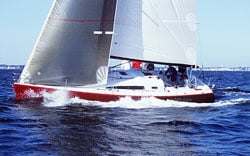
After sailing upwind for a while it was time to test the Farrs downwind capability. The one-design class allows for a choice of 2 masthead asymmetric spinnakers set from a retractable sprit. We had the small one aboard, but this still had plenty of horsepower. Fellow judge Chuck Allen found the boat “easy to steer on reaches without losing the rudder”. He wanted to use the larger–mostly in the shoulders–spinnaker, but Ive yet to meet a sailmaker that didnt want more sail area! The boat has obvious breakaway potential and wanted to leap on any wave it could find. We dropped the kite and rounded a “leeward mark”, easily but Chuck thought he could feel the rudder stall as he made the tight turn. Care in steering is the price you pay for high aspect ratio foils and Chuck still gave the 395 an enthusiastic thumbs up.
Farr International has come up with a truly fine boat with the 395. Its great example of a racing boat that one could really cruise. Throw in a one-design class well managed by Farr International, a PHRF handicap of 30-36 and the 395 has many venues for competition. This kind of boat, however, comes with a price tag. Out of the several good boats in the 30-40 foot Racer/cruiser category this year, this was the most expensive at a base price of $222,000. Still, we concurred that, if you have the budget to support it, the 395 is the obvious choice.
Farr 395
LOA 39.3 ft.
Beam 12.1 ft.
Draft 7.8 ft.
DSPL 12,250 lbs.
SA 1,000 sq. ft.
www.farrinternational.com
www.farr395.org
For a review of the Farr 395 click here.

